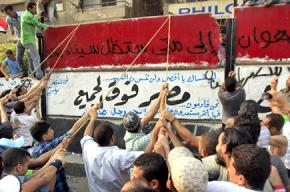Under fire outside the Israeli embassy
reports from Cairo on a new battle pitting masses of Egyptians against the military and its support for the status quo, including Egypt's ties to Israel.
HUNDREDS OF protesters stormed into the Cairo building housing the Israeli embassy during a demonstration September 9. The protesters succeeded in breaking into the embassy offices, where they seized hundreds of documents exposing the close relationship between Israel and the Egyptian government and business interests.
But a night of celebration among the thousands who cheered on the embassy occupiers inside turned bloody. Security forces and army personnel clashed with the demonstrators, indiscriminately assaulting anyone in the streets and filling the air with tear gas. At least three people were killed and more than 1,000 reported injured.
The takeover of the embassy and the attack on protesters that followed is the latest sign of the escalating conflict between the military rulers who took over after dictator Hosni Mubarak was toppled and masses of people who want the new regime to honor its promises of sweeping democratic and economic reforms.
Meanwhile, the international media used the takeover as an excuse to smear the demonstrators as a small group of thugs bent on violence and mayhem toward a symbol of the Jewish state. But the protests are broadly popular because Egyptians want the new government to cut Egypt's economic and political ties built up by the U.S.-backed Mubarak dictatorship over many years. That's the source of the increasingly angry demonstrations outside the embassy over the past months.

THE SEPTEMBER 9 embassy takeover followed a larger demonstration in Tahrir Square that afternoon. Some 20,000 to 30,000 people came out for a protest called by Egypt's left and liberal political currents and dubbed "Correcting the Path." Protesters marched from multiple locations into downtown Cairo to call on the government to end military trials and other examples of continuing repression.
At the same time, several thousand people had gathered outside the Israeli embassy, which is located in a residential building overlooking the Nile. The embassy has been the target of demonstrations since August, after an Israeli military assault against Palestinians in Gaza caused casualties across the border, killing six Egyptian soldiers in the Sinai.
At a mid-August protest following those deaths, demonstrators tore down the corrugated metal fence protecting the building. One man, Ahmed Shahat, won international renown by scaling the outside of the 22-story building to tear down the Israeli flag flying on top.
The demonstrations have continued since, with many sharing the sentiment that Egypt should follow the example of Turkey in the wake of the killing of nine Turkish citizens during Israel's assault on the Mavi Marmara aid ship and suspend diplomatic, military and trade relations. Other demands include revising or canceling the Camp David accords and the ending sales of natural gas to Israel. Although it was widely rumored that Israel's ambassador to Egypt would be expelled, the military council that rules Egypt conceded to diplomatic pressure and allowed him to remain.
On September 9, protesters at the embassy spent the afternoon dismantling a new concrete wall constructed by the local government. As evening began, a portion of the protesters from the Tahrir demonstration swelled their ranks. As one eyewitness report on Ahram Online described the scene:
We arrived on the scene and found at least 5,000 people surrounding the building, and they were chanting "Down, down with Israel!" and celebrating. The tall concrete wall, which for many Egyptians was an ugly reminder of Israel's notorious Separation Wall on the West Bank, had been turned to rubble.
People were walking around with big chunks of stones from the one week old barrier, planning to take them home as souvenirs. This was Egypt's small "Berlin Wall" moment.
Around 8 p.m., hundreds of Egyptians stormed the entrance to the building and succeeded in getting inside. Soldiers were guarding the building, but witnesses report they refused to attack the protesters. Once inside, the demonstrators broke into the embassy itself, using sledgehammers to break down the doors.
A couple hours later, the protesters inside the embassy began dumping thousands of pages of paper from the upper-story windows. As the Ahram Online report described it:
As the papers made their way down slowly to the pavement, the crowd was first under the impression that the revolutionaries were sending us a photocopied political statement of some sort. We caught the papers and examined them. It took hundreds of people a few minutes of sorting through them before we realized that we were looking at Israeli embassy records in Arabic, Hebrew and English...
At this moment, the crowd went wild and started pushing and shoving to catch whatever papers were coming down from the heavens. Those who could not catch fallen documents gathered in small groups to read what others caught, and took pictures with mobile phones. I walked from one group of "examiners" to the other trying to look at as many documents as possible.
There were records of phone deals between major Egyptian private and public telecommunications firms and Israel. I also saw documents that listed names of business transactions between the embassy and all sorts of Egyptian authorities, from customs officials to CEOs of tourism firms, bringing Israeli travelers to Egypt, and on and on.
The scene outside the embassy recalled similar ones in March when crowds in Cairo, Alexandria and around the country stormed the headquarters of the hated Security Services Administration, seizing documents as evidence of the state's crimes against its citizens.
As happened then, the photographed pages were posted on the Internet. They show the extent of dealings between Egypt and Israel that have been kept hidden from the public until now--in just a few days, they have caused waves of controversy and discussion in the Egyptian media.
SHORTLY BEFORE the documents were dumped out of the embassy, squads of black-clad riot police from the notorious Central Security Forces (CSF) were dispatched to the scene. This led to battles with hundreds of young Egyptians who confronted the police. Two CSF trucks were set ablaze. The confrontations spread through the nearby side streets around the Saudi Arabian embassy and the local headquarters of the Interior Ministry.
Around midnight, conflicts between protesters and police escalated furiously. The riot cops released wave after wave of tear gas. As it billowed out from canisters, several protesters collected them to prove that this chemical weapon was supplied by the U.S. government.
According to witnesses, while demonstrators fought back with rocks and whatever they could, police fired both live and rubber bullets into the air and also into the crowd. Video footage of the clashes shows that police attempted to use security vans to run over protesters. As the report on Ahram Online described it:
In the first hours of the fight, I had anticipated that the police were bound to run out of these made-in-USA products sooner or later. Veteran protesters, based on their previous experiences also expected it, especially considering the pace at which police were lobbing tear gas canisters. A number of those veterans kept pleading with their now exhausted comrades to hold for another 10 or 20 or 40 minutes, assuring them that the police will "soon" and "very soon" run out of canisters and bullets.
"Soon" never came. The Egyptian police--whose new motto after the revolution is "the police is in the service of the people, not any regime"--seem to have signed a deal-of-the century contract with some heartless American arms producer that allowed it to secure for itself an assembly line guaranteeing an endless supply of canisters and rubber bullets.
The battle raged through the night, with at least three dead and more than 1,000 people injured. Several hundred people have been arrested for taking part in the demonstrations.
The Supreme Council of the Armed Forces responded by renewing the declaration of the state of emergency, which has been continuous since 1981, but only leniently enforced in the months since the revolution. The Israeli ambassador and his family fled Egypt, along with embassy staff.
All this is further evidence of the deep conflict between the hopes of the Egyptian people for fundamental change and the priorities of the military rulers as they attempt to impose order. The September 9 clashes were the greatest use of state force since the Battle of the Camel on January 28, while Mubarak was still clinging to power.
While popular anger reinvigorates the revolutionary opposition, the military regime is in a state of crisis, torn between the geopolitical pressures brought to bear by Israel and the U.S., and the growing pressure from protesters. Prime Minister Essam Sharaf has tendered his resignation for the third time; it was again refused.
Meanwhile, strikes and other protests have continued. Teachers, doctors and other workers walked out on September 11, university students organized demonstrations that day as well, and more strikes are scheduled for the coming weeks.
The increasing frictions between the military government and the Egyptian people are once again producing sparks. The next few months will show if they ignite again into a revolutionary conflagration.


